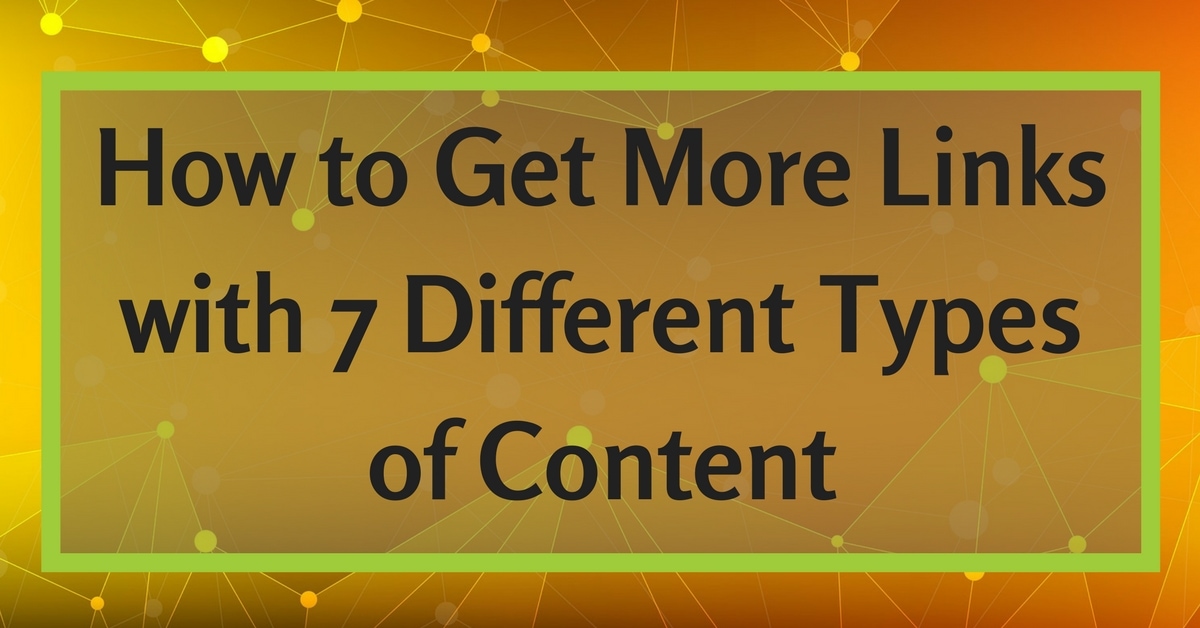Content can be used for a variety of different things, from attracting search engine traffic to getting a cacophony of likes on social media.
However, one of the biggest targets for people creating content on their websites remains attracting links, whether from blogs, top-tier news publications, or anything in between.
Knowing who and what you’re creating content for is crucial in finding link building success.
In the same way that you should create different kinds of content for different channels, you should also create different kinds of content for different link targets.
Creating the same kind of content, targeted at the same people over and over again, won’t broaden the variety of links you get; it will usually lead to you getting links in the same places over and over again.
We know that most SEO value comes from the first link you get on a domain, so creating different kinds of content that target different kinds of authors and publications will give you a better chance of getting coverage across a wider set of sites.
There are many different types of content you can create which can attract links, and if you ensure you cover as many of them as possible you’ll give yourself the best possible chance of getting links across a broader set of sites.
I’ve pulled together some of my favorite types of content that we use to get links at SEO Travel, along with tips on how to maximize them.

Creating content on your site that is link-worthy is a great start to this process, as it can leave you with assets that stand the test of time and that you can use over and over again to get links into the future.
I’ve highlighted four of my favorites below. All need a bit of time to bear fruit, but if you invest the time up front you will reap the rewards when they are ready.
1. Reference Content
One of the biggest reasons for linking on the web is to support what you’re saying with statistics.
Therefore, if you create pages on your site that include the data to back up people’s argument, then you’ll have a great chance of being referenced and linked to whenever that topic is written about.
This doesn’t mean you have to conduct expensive in-depth studies to create new data, you can simply aggregate the information that’s already out there.
Hubspot has a great example of this with their marketing statistics page which has 2,056 linking domains!
In travel, pricing pages are a great example of this, such as this backpacker index on Price of Travel which breaks down the costs of a variety of cities and has 17 domains linking to it, with each individual place page on the site also attracting lots of links.
2. Host an Event
Creating and hosting an event is a great way to attract links as people need to link back to your page so people can sign up or get tickets.
It also has inbuilt methods of promotion, as speakers will always be happy to share it and will likely link back to it from personal sites where they talk about their speaking experience.
You can also add it to event listing sites like Event Brite. Some of these will be nofollowed, but there are many with followed links out there you can add your event to.
People also like to create lists of the best conferences and events in an industry, so you give yourself the opportunity to be featured in those kinds of posts too.
Branded3 are a great example of this in action having launched their Search Leeds conference this year, which has already racked up links from nearly 40 domains, many of which are extremely powerful.
3. Do a Study
New research is always a popular way of getting links, particularly if you can find a topic or angle that people in your industry are struggling with.
This type of approach is one that takes time and effort to implement, but if you land on a great angle you can then turn it into a recurring study each year and create an ongoing outreach opportunity.
Orbit Media does a fantastic job of this with their Blogger Trends research being particularly successful, attracting links from 164 domains and counting. They’re now on their third iteration of the study, and no doubt will continue long into the future as it continues to gain traction.
Don’t be too concerned about spending lots of time on research and ending up with an outcome that’s different to your desired hypothesis either.
MailChimp did a study on the ideal length of an email subject line and found that it didn’t matter at all! However, the post has still attracted links from 68 domains, with some of the most powerful sites on the web amongst them.
4. Create Tools
As with events, tools are a fantastic way to attract links as you are providing value for your audience and the natural thing for people to do when referencing it is to link through to where people can use it.
You can do this in two ways; free or paid. Some companies use their tools as a premium offering and spend a lot of time making them best-in-class, serving as standalone software companies in their own right.
Screaming Frog is a great example of this, with various tools that have attracted a huge amount of links over the years (3,792 linking domains). Many people might think of them solely as a software company, but they are also an agency and rank on page 1 for “seo”, “seo agency”, and various other phrases that are the most competitive in the industry.
But you don’t have to spend as much time as that to use tools as a link building approach.
Built Visible have created a variety of free tools for people to use that have attracted a wealth of links, such as their SEO Gadget for Excel (42 linking domains) and Content Strategy Helper (61 linking domains). These won’t require anywhere near the amount of upkeep as Screaming Frog, but still offer great value and so people love referencing and recommending them.
And as with events, there are lots of blog posts out there about the best tools in an industry (particularly in SEO) so there are lots of outreach opportunities to be had if you want to be proactive about promoting your tool. And if you don’t believe me, SEJ has a whole section dedicated to it!

So you’ve created lots of fantastic content on your site that is built to attract links, but some of those take a long time to come to fruition and often levels of effort and investment that aren’t feasible for smaller businesses.
What other options are available?
There are some great ways to get coverage on big publications without having to build tools, conduct studies or host events. This boils down to creating interesting content that you can give to third parties to feature and making the process for them to publish it as easy as possible.
This could be classified as ‘content marketing’ in today’s jargon, but boils down to good old-fashioned publicity of something you’ve created. However, the key is to create alternative styles of content that are targeted at different types of publication. This gives you the potential to get featured on a much wider variety of sites in a larger cross-section of industries, and therefore more links that will help drive forward your performance!
5. Maps
Another popular approach is creating maps that illustrate some form of information.
Maps allow you to illustrate information from around the world, which means you can pitch it to publications in any country with an angle based on their country and audience.
Large national news publications often feature them if the topic is prominent enough, and it’s also a popular style of content on Reddit which many journalists and website editors use as a source of stories for their own sites. If you get something to take off on Reddit, you’ll likely find that the links will follow.
I wrote a case study of how we did this to get more than 100 links for a site, which breaks the process down step-by-step. You can follow our exact approach if you wish.
6. Infographics
There’s nothing groundbreaking about infographics, but it’s amazing how many people are still doing this wrong. Simply churning out a graphic with some figures on will never be enough to get you links and coverage.
You need to illustrate information that proves a point or shows off information that people will want to use as a reference to support the article they’re writing.
For example, this wine and food pairing infographic can always be used as a reference for people writing about food or diet, and it looks beautiful too. That’s why it’s got links from the likes of Business Insider, Lifehack, and many others.
Don’t create infographics for the sake of it, think of a story you (and others) want to tell with the information and then create something beautiful to highlight that angle.
Infographics like this are generally great for links from sites in your own niche, as well as some of the bigger news-style sites like Business Insider and BuzzFeed who will usually find a way to publish interesting content when it comes their way. If you can tie it in with topical news stories then you can also find your way into national news publications like the Independent or Daily Mail in the UK.
7. Illustrations
Creating illustrations is a great way to open up your outreach to design-led sites, who publish content very regularly and are always on the lookout for beautiful design. Places like My Modern Met and Design Taxi are great targets for this kind of approach and both are very powerful.
Your approach can vary, from creating retro posters to faux book covers – as long as it looks beautiful and is an interesting concept you will have a great chance of gaining coverage.
This approach also allows you to tie into popular culture too, creating illustrations that tie together your topic and the kind of things pop culture publications want to talk about. We did this by creating illustrations of the Instagram feeds of Disney Princesses (a perennial topic of interest) on holiday, that was covered in Cosmopolitan and Glamour amongst many others.
These kinds of publications aren’t usually interested in infographics or covering the content businesses have created on their own site, so illustrations open a new door to get links and coverage from them.

The key to getting great links isn’t a mystery, but it does need some creative juice and good old-fashioned elbow grease. Hopefully, these examples will give you some inspiration for types of content that you can use to go and get started.
The key points to remember are:
- Create different content for different types of site.
- Tailor your content to those different audiences.
- Always build in promotion methods into your content – I wrote about an easy way you can do that here.
If you’re prepared to work hard and invest in the long-term benefit that these types of content can bring then you’ll be well on the way to a beautiful link profile and coverage you can be proud of!
More Link Building Resources Here:
- 8 Modern Link Acquisition Tactics that Work
- 7 Content Types That Gain the Most Engagement & Links
- 10 Types of Content That Will Earn Links Naturally
Image Credits
Featured and In-post Images: Created by Tom McLoughlin, October 2017.





![AI Overviews: We Reverse-Engineered Them So You Don't Have To [+ What You Need To Do Next]](https://www.searchenginejournal.com/wp-content/uploads/2025/04/sidebar1x-455.png)